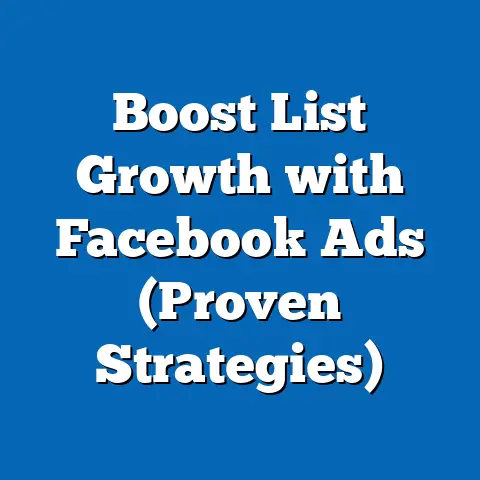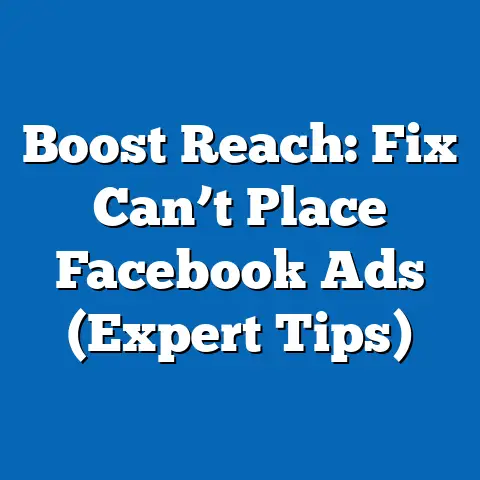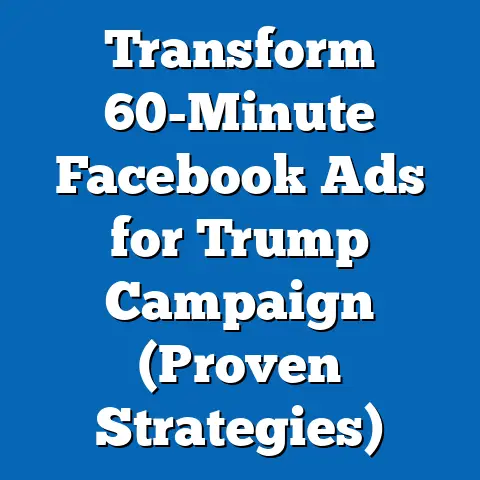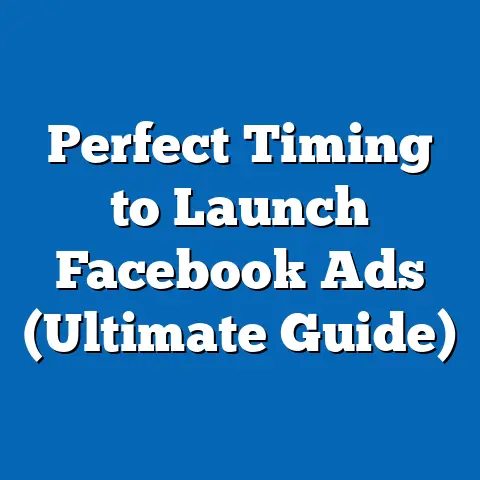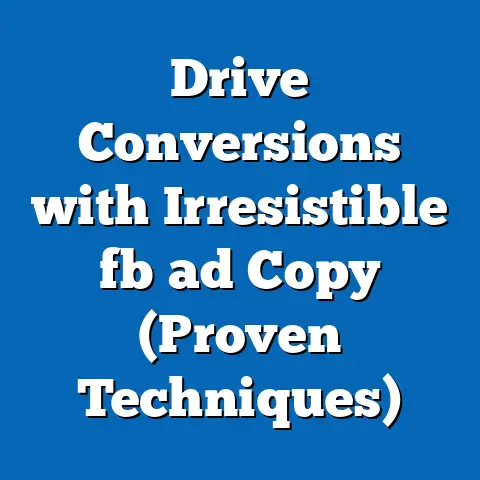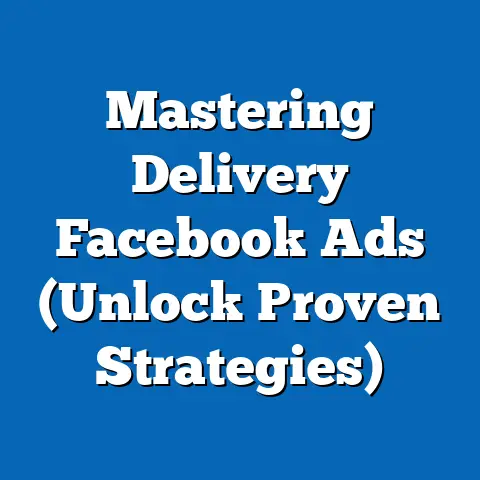Boost Recruitment with Powerful Facebook Ads (Pro Strategies)
Ever feel like recruitment is like throwing spaghetti at the wall, hoping something sticks? I’ve been there. You post a job opening, and suddenly your inbox is flooded with applications… from people who seem to have completely missed the job description. Like the time I got a resume from a cat applying to be a dog trainer. Seriously! That’s when I realized I needed a better strategy. Today, I’m going to show you how to revolutionize your hiring process using the power of Facebook ads. Trust me, it’s a game-changer.
Understanding the Power of Facebook Ads in Recruitment
Facebook isn’t just for sharing vacation photos and arguing about politics; it’s a goldmine for finding talent. With billions of active users worldwide, Facebook offers unparalleled reach and demographic diversity. This means you can connect with potential candidates across various industries, experience levels, and backgrounds, all in one place.
The real magic of Facebook ads lies in its precise targeting capabilities. Unlike traditional job boards where you’re essentially casting a wide net, Facebook allows you to narrow your focus with laser-like accuracy. Imagine being able to target candidates based on their job titles, skills, interests, education, and even their behavior on the platform. This level of precision not only saves you time but also ensures that your job postings reach the right people, significantly reducing the number of unqualified applications you have to sift through.
Setting Up Your Facebook Recruitment Campaign
Okay, let’s get down to brass tacks. Setting up a Facebook recruitment campaign might seem daunting at first, but trust me, it’s easier than teaching a cat to fetch (though, maybe not by much!). Here’s a step-by-step guide to get you started:
-
Create a Facebook Ad Account: If you don’t already have one, you’ll need to set up a Facebook Ad Account. This is where you’ll manage all your campaigns, budgets, and ad creatives.
-
Choose Your Campaign Objective: When creating a new campaign, Facebook will ask you to choose an objective. For recruitment, I typically recommend “Traffic,” “Engagement,” or “Lead Generation,” depending on your specific goals. If you want candidates to visit your careers page, “Traffic” is a great choice. If you want them to engage with your ad by liking, sharing, or commenting, “Engagement” is the way to go. And if you want to collect their information directly through a form, “Lead Generation” is your best bet.
-
Define Your Target Audience: This is where the magic happens. Facebook allows you to target your ads based on a wide range of criteria, including demographics, interests, behaviors, and connections. I’ll dive deeper into targeting strategies in the next section.
-
Choose Your Ad Placement: You can choose to show your ads on Facebook, Instagram, Audience Network, and Messenger. For recruitment, I usually focus on Facebook and Instagram, as these platforms tend to be more effective for reaching potential candidates.
-
Set Your Budget and Schedule: Decide how much you’re willing to spend on your campaign and how long you want it to run. You can set a daily budget or a lifetime budget, depending on your preferences.
-
Create Your Ad Creative: This is where you’ll design your ad, including the headline, body text, image or video, and call-to-action button. I’ll provide some tips on crafting compelling ad copy in the next section.
-
Choose the Right Ad Format: Facebook offers several ad formats, each with its own strengths and weaknesses. For recruitment, I recommend the following:
-
Single Image Ads: These are simple and effective for showcasing a specific job opening. Use a high-quality image that captures attention and conveys your company culture.
-
Video Ads: Videos are great for telling your company’s story and showcasing what it’s like to work for you. Consider creating a short video featuring current employees talking about their experiences.
-
Carousel Ads: Carousel ads allow you to display multiple images or videos in a single ad unit. This is a great way to showcase multiple job openings or highlight different aspects of your company culture.
-
Collection Ads: Collection ads are designed for e-commerce, but they can also be used for recruitment. They feature a cover image or video followed by a grid of related products or job openings.
-
-
Crafting Compelling Ad Copy: Your ad copy is your opportunity to grab the attention of potential candidates and convince them to apply. Here are some tips for writing effective ad copy:
-
Start with a Hook: Grab the reader’s attention with a compelling headline or opening sentence.
-
Highlight the Benefits: Focus on what the candidate will gain by working for you, such as career growth opportunities, competitive salaries, or a positive work environment.
-
Use Action Verbs: Encourage candidates to take action by using strong verbs like “Apply Now,” “Learn More,” or “Join Our Team.”
-
Keep it Concise: People are busy, so get to the point quickly.
-
Use an Approachable Tone: Avoid jargon and write in a way that is easy to understand.
-
Create a Facebook Ad Account: If you don’t already have one, you’ll need to set up a Facebook Ad Account. This is where you’ll manage all your campaigns, budgets, and ad creatives.
Choose Your Campaign Objective: When creating a new campaign, Facebook will ask you to choose an objective. For recruitment, I typically recommend “Traffic,” “Engagement,” or “Lead Generation,” depending on your specific goals. If you want candidates to visit your careers page, “Traffic” is a great choice. If you want them to engage with your ad by liking, sharing, or commenting, “Engagement” is the way to go. And if you want to collect their information directly through a form, “Lead Generation” is your best bet.
Define Your Target Audience: This is where the magic happens. Facebook allows you to target your ads based on a wide range of criteria, including demographics, interests, behaviors, and connections. I’ll dive deeper into targeting strategies in the next section.
Choose Your Ad Placement: You can choose to show your ads on Facebook, Instagram, Audience Network, and Messenger. For recruitment, I usually focus on Facebook and Instagram, as these platforms tend to be more effective for reaching potential candidates.
Set Your Budget and Schedule: Decide how much you’re willing to spend on your campaign and how long you want it to run. You can set a daily budget or a lifetime budget, depending on your preferences.
Create Your Ad Creative: This is where you’ll design your ad, including the headline, body text, image or video, and call-to-action button. I’ll provide some tips on crafting compelling ad copy in the next section.
Choose the Right Ad Format: Facebook offers several ad formats, each with its own strengths and weaknesses. For recruitment, I recommend the following:
-
Single Image Ads: These are simple and effective for showcasing a specific job opening. Use a high-quality image that captures attention and conveys your company culture.
-
Video Ads: Videos are great for telling your company’s story and showcasing what it’s like to work for you. Consider creating a short video featuring current employees talking about their experiences.
-
Carousel Ads: Carousel ads allow you to display multiple images or videos in a single ad unit. This is a great way to showcase multiple job openings or highlight different aspects of your company culture.
-
Collection Ads: Collection ads are designed for e-commerce, but they can also be used for recruitment. They feature a cover image or video followed by a grid of related products or job openings.
Single Image Ads: These are simple and effective for showcasing a specific job opening. Use a high-quality image that captures attention and conveys your company culture.
Video Ads: Videos are great for telling your company’s story and showcasing what it’s like to work for you. Consider creating a short video featuring current employees talking about their experiences.
Carousel Ads: Carousel ads allow you to display multiple images or videos in a single ad unit. This is a great way to showcase multiple job openings or highlight different aspects of your company culture.
Collection Ads: Collection ads are designed for e-commerce, but they can also be used for recruitment. They feature a cover image or video followed by a grid of related products or job openings.
Crafting Compelling Ad Copy: Your ad copy is your opportunity to grab the attention of potential candidates and convince them to apply. Here are some tips for writing effective ad copy:
-
Start with a Hook: Grab the reader’s attention with a compelling headline or opening sentence.
-
Highlight the Benefits: Focus on what the candidate will gain by working for you, such as career growth opportunities, competitive salaries, or a positive work environment.
-
Use Action Verbs: Encourage candidates to take action by using strong verbs like “Apply Now,” “Learn More,” or “Join Our Team.”
-
Keep it Concise: People are busy, so get to the point quickly.
-
Use an Approachable Tone: Avoid jargon and write in a way that is easy to understand.
Start with a Hook: Grab the reader’s attention with a compelling headline or opening sentence.
Highlight the Benefits: Focus on what the candidate will gain by working for you, such as career growth opportunities, competitive salaries, or a positive work environment.
Use Action Verbs: Encourage candidates to take action by using strong verbs like “Apply Now,” “Learn More,” or “Join Our Team.”
Keep it Concise: People are busy, so get to the point quickly.
Use an Approachable Tone: Avoid jargon and write in a way that is easy to understand.
Targeting the Right Audience
Remember that cat who thought it could train dogs? That’s what happens when you don’t target your audience correctly. You end up wasting time and money on people who aren’t a good fit. To avoid this, you need to define your target demographics for recruitment ads.
- Demographics: This includes factors like age, gender, education, location, and job title. For example, if you’re hiring for an entry-level position, you might want to target recent college graduates in a specific geographic area.
- Interests: This includes things like hobbies, interests, and activities. For example, if you’re hiring for a software engineer, you might want to target people who are interested in coding, technology, or startups.
- Behaviors: This includes things like purchase behavior, device usage, and travel habits. For example, if you’re hiring for a sales position, you might want to target people who have a history of making online purchases or who travel frequently for work.
- Connections: This allows you to target people who are connected to your Facebook page, event, or app. You can also target their friends or exclude them from your targeting.
One of my favorite tools for gathering data on potential candidates and tailoring ads accordingly is Facebook’s Audience Insights. This tool provides valuable insights into the demographics, interests, and behaviors of your target audience. You can use this information to create more targeted ads that resonate with potential candidates.
Custom Audiences and Lookalike Audiences
- Custom Audiences allow you to upload a list of email addresses or phone numbers to target people who have already expressed interest in your company. This is a great way to reach past applicants or people who have visited your careers page.
- Lookalike Audiences allow you to create an audience that is similar to your existing customers or website visitors. This is a great way to reach new people who are likely to be interested in your job openings.
Crafting Irresistible Job Ads
Let’s be honest, most job ads are boring. They’re filled with jargon, buzzwords, and generic descriptions that don’t tell you anything about the company or the job. To stand out from the crowd, you need to create job ads that are irresistible.
- Headlines: Your headline is the first thing people will see, so make it count. Use a compelling headline that grabs attention and highlights the benefits of the job.
- Visuals: Use high-quality images or videos that showcase your company culture and values. Avoid using stock photos that look generic and impersonal.
- Calls-to-Action: Tell people what you want them to do. Use strong action verbs like “Apply Now,” “Learn More,” or “Join Our Team.”
- Showcase Company Culture: People want to work for companies that have a positive work environment and values that align with their own. Use your job ads to showcase your company culture and values.
- Highlight Benefits: Focus on what the candidate will gain by working for you, such as career growth opportunities, competitive salaries, or a positive work environment.
I’ve seen some incredibly successful job ads that have attracted top talent. One example that comes to mind is a company that created a video ad featuring current employees talking about their experiences. The video was authentic, engaging, and showcased the company’s positive work environment. As a result, the company received a flood of applications from highly qualified candidates.
Budgeting and Bidding Strategies
Setting a budget for recruitment campaigns can be tricky, but it’s essential to ensure that you’re not overspending or underspending. You need to consider the following factors:
- Your Recruitment Goals: How many people do you need to hire? What types of positions are you hiring for?
- Your Target Audience: How large is your target audience? How competitive is the market for the talent you’re seeking?
- Your Ad Performance: How well are your ads performing? Are you getting a good return on your investment?
Facebook offers two main types of budgets:
- Daily Budget: This is the average amount you’re willing to spend each day.
- Lifetime Budget: This is the total amount you’re willing to spend over the entire duration of your campaign.
Facebook also offers several bidding strategies:
- Cost Per Click (CPC): You pay each time someone clicks on your ad.
- Cost Per Impression (CPM): You pay each time your ad is shown to someone.
- Cost Per Action (CPA): You pay each time someone takes a specific action, such as filling out a form or applying for a job.
For recruitment, I typically recommend using CPC or CPA bidding, as these strategies allow you to pay only when someone takes a specific action that is valuable to you.
It’s crucial to monitor and adjust your budgets based on ad performance metrics. If your ads are performing well, you might want to increase your budget to reach more people. If your ads are not performing well, you might want to decrease your budget or try a different bidding strategy.
Analyzing and Optimizing Your Campaigns
Once your recruitment campaigns are up and running, it’s essential to monitor their performance and make adjustments as needed. Here are some of the key performance indicators (KPIs) to monitor:
- Click-Through Rate (CTR): This is the percentage of people who see your ad and click on it. A high CTR indicates that your ad is relevant and engaging.
- Conversion Rate: This is the percentage of people who click on your ad and take a desired action, such as filling out a form or applying for a job. A high conversion rate indicates that your ad is effective at driving results.
- Cost Per Hire: This is the amount you’re spending to hire each employee. A low cost per hire indicates that your recruitment campaigns are efficient.
Facebook Ads Manager provides a wealth of data on campaign performance. You can use this data to identify areas for improvement and make adjustments to your targeting, ad creative, and bidding strategies.
One of the most effective ways to improve your results is to A/B test different ad versions. This involves creating two or more versions of your ad with slight variations and testing them against each other to see which one performs better. You can test different headlines, images, body text, and calls-to-action.
Success Stories and Case Studies
I’ve seen firsthand how Facebook ads can revolutionize the recruitment process. One of my clients, a tech startup, was struggling to find qualified software engineers. They had tried traditional job boards and recruitment agencies, but they weren’t getting the results they needed.
I suggested that they try using Facebook ads to target potential candidates based on their skills, interests, and experience. We created a series of compelling job ads that showcased the company’s innovative culture and the opportunity to work on cutting-edge technology.
The results were astounding. Within a few weeks, the company had received hundreds of applications from highly qualified software engineers. They were able to hire several top-notch engineers who had previously been out of reach.
This is just one example of how Facebook ads can be used to boost recruitment efforts. By targeting the right audience, crafting irresistible job ads, and monitoring and optimizing your campaigns, you can attract top talent and revolutionize your hiring process.

